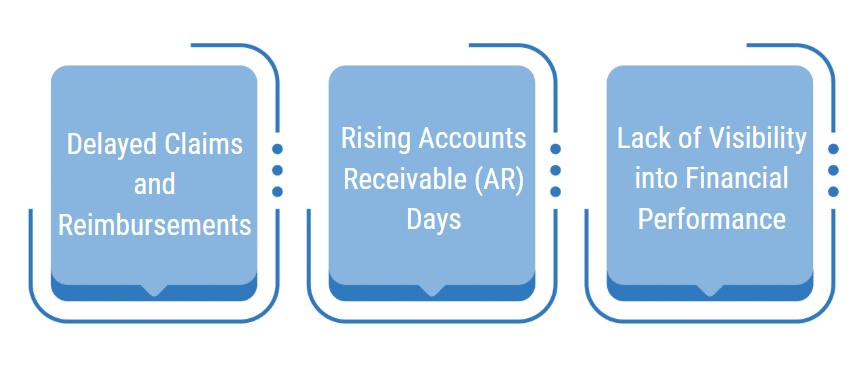High Patient Volume Doesn’t Always Mean High Profit
In today’s ambulatory care landscape, packed schedules are often mistaken for strong financial performance. But behind the scenes, many clinic administrators and physicians face a frustrating paradox: patient volume is high, yet profit margins remain stagnant, or worse, shrinking. The culprit? Silent revenue leaks hide in plain sight.
Whether it is delayed reimbursements, outdated billing processes, or reports that lack actionable insight, these issues often go unnoticed until the financial strain becomes impossible to ignore. High-performance in-patient care doesn’t automatically translate to high performance in revenue management.
With deep roots in ambulatory care, John Lynch & Associates helps clinics turn complex operational challenges into sustainable revenue strategies. In this article, we will walk through three proven strategies for ambulatory revenue optimization to help your clinic close financial gaps and position itself for long-term stability.
- 1. High Patient Volume Doesn’t Always Mean High Profit
- 2. Symptom Check: Are These Financial Red Flags Present?
- 3. Strategy 1: Enhance Billing Workflows with Automation
- 4. Strategy 2: Analyze Payer Mix + Denial Patterns
- 5. Strategy 3: Use Financial Reports to Guide Staffing and Service Decisions
- 6. Partner with John Lynch & Associates to Optimize Operations and Revenue
- 7. Related Articles
Symptom Check: Are These Financial Red Flags Present?

Delayed Claims and Reimbursements
Rising Accounts Receivable (AR) Days
Lack of Visibility into Financial Performance
Strategy 1: Enhance Billing Workflows with Automation
Manual Process Pitfalls
Benefits of Automation
Modern billing platforms can integrate with your EHR and practice management system to streamline coding, validate claims, and accelerate reimbursements. Automation also allows teams to refocus on exceptions and strategic tasks, rather than spending hours pushing paper.
Clinics that have implemented billing automation have seen measurable results: reduced AR days, higher clean claim rates, and fewer denials on first pass. In short, automation makes it easier to get paid faster and more consistently.
Strategy 2: Analyze Payer Mix + Denial Patterns
Identifying Profit Drains
Every contract your clinic holds with a payer has implications beyond reimbursement rates. High-denial payers, excessive prior authorization requirements, or those with complex billing rules can quietly chip away at your revenue. But unless your team is regularly analyzing denial data using proven strategies, these trends remain invisible.
Start by identifying your top five payers by volume and revenue, then break down denial rates, payment timelines, and write-offs for each. These patterns often reveal where renegotiation, appeals focus, or a service shift could recapture significant income.
Strategic Payer Management
When clinics understand which payers are most reliable- and which consistently delay or deny claims- they can make smarter decisions about scheduling, marketing, and even service line development. This is not about reacting to denials. It’s about using data to proactively shape your revenue strategy.
At John Lynch & Associates, we guide clinics in building custom denial dashboards that integrate with their practice management systems. These dashboards break down denials by payer, service line, and denial reason code; allowing clinics to filter trends over time. By automating this visibility, leaders can target the top 3-5 denial drivers with payer-specific appeals protocols and staff training, resulting in faster resolution and improved reimbursement rates.

Strategy 3: Use Financial Reports to Guide Staffing and Service Decisions
Aligning Staff with Service Demand
Making Reports Actionable
The key is not just accessing financial data but knowing how to act on it. Dashboards that consolidate metrics like provider productivity, revenue per visit, and payer performance in near-real time enable clinic leaders to make fast, informed decisions.
Some practices are already seeing results by leveraging interoperability to align staffing and operations, improving both efficiency and care quality across their service lines.
Partner with John Lynch & Associates to Optimize Operations and Revenue
When it comes to financial health, even the busiest ambulatory clinics can find themselves on unstable footing. Delayed claims, poor payer performance, and underutilized data systems silently chip away at profitability every day. The good news? These challenges are fixable, with the right approach.
We help ambulatory practices turn insight into action. Our team brings together deep healthcare expertise, operational precision, and technology-forward thinking to close financial gaps and position your organization for long-term success.
Ready to uncover hidden revenue in your clinic? Let’s start a conversation. Schedule a discovery call to begin transforming your clinic’s performance today.
Ready to Talk?




